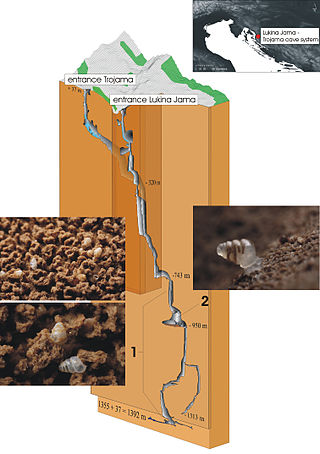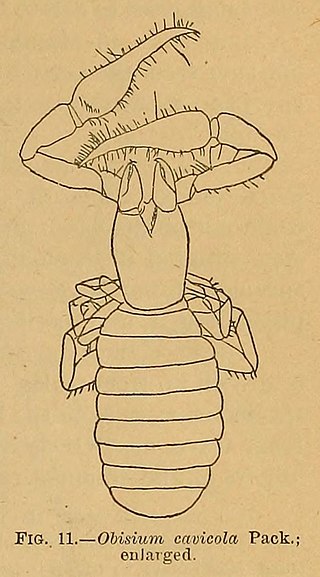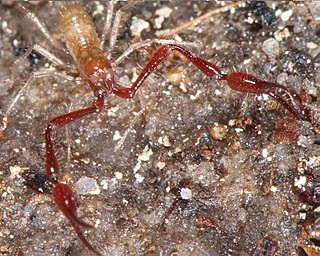
Pseudoscorpions, also known as false scorpions or book scorpions, are small, scorpion-like arachnids belonging to the order Pseudoscorpiones, also known as Pseudoscorpionida or Chelonethida.
Fauna Europaea is a database of the scientific names and distribution of all living multicellular European land and fresh-water animals. It serves as a standard taxonomic source for animal taxonomy within the Pan-European Species directories Infrastructure (PESI). As of June 2020, Fauna Europaea reported that their database contained 235,708 taxon names and 173,654 species names.

Biospeleology, also known as cave biology, is a branch of biology dedicated to the study of organisms that live in caves and are collectively referred to as troglofauna.

Neobisiidae is a family of pseudoscorpions distributed throughout Africa, the Americas and Eurasia and consist of 748 species in 34 genera. Some species live in caves while some are surface-dwelling.
Bollmania is a genus of millipedes with around six species occurring from Central through East Asia, including Iran, Pakistan, Tajikistan, and China. The genus was established by entomologist Filippo Silvestri in 1896, and is named in honor of Charles Harvey Bollman. Bollmania is the sole genus of the family Caspiopetalidae.
Duhlata is a cave situated in Vitosha mountain, western Bulgaria. With a total length of 18,200 m, Duhlata is the second longest cave in the country. It was declared a natural monument in 1962. The cave is home to six species of bats.

Hans Henderickx (1961–2016) was a Belgian entomologist specializing in Invertebrates born in Mol, Belgium.

Neobisium is a genus of pseudoscorpions in the family Neobisiidae.
Hesperochernes is a genus of pseudoscorpions in the family of Chernetidae.
Neobisium incertum is a species of pseudoscorpions in the Neobisiidae family. The type locality is Sorgono in Italy, and the species is endemic to Sardinia.

Chitrella is a genus of pseudoscorpions in the family of Syarinidae.
Austrochernes is a genus of pseudoscorpions in the subfamily Chernetinae, first described by Max Beier in 1932. Species of this genus are found in mainland Australia and New Guinea. The Australian Faunal Directory decisions for synonymy are based on a 2018 paper by Mark Harvey.

The Tooth Cave pseudoscorpion(Tartarocreagris texana) is a small cave-dwelling arachnid of the family Neobisiidae. The species was originally assigned to the genus Microcreagris, and then reassigned to Austalillocregris before arriving at its current genus, Tartarocreagris. The Tooth Cave pseudoscorpion has a small geographic distribution, known to occur in only two caves in Travis County, Texas. Additionally, it is tentatively identified in two nearby caves in Texas, but more research is necessary to accurately define the range where the species lives. There is little known about the biology, life cycle, and life history of the Tooth Cave pseudoscorpion due to a lack of research and study. Because of this, the Tooth Cave pseudoscorpion is listed on the IUCN Red List as data deficient. Under the Endangered Species Act, the Tooth Cave pseudoscorpion is listed as endangered. Recovery plans for the species focus mostly on preserving the karst ecosystem that the pseudoscorpions live in, especially including lessening human impacts on the environment.
Pseudotyrannochthonius hamiltonsmithi is a species of pseudoscorpion in the Pseudotyrannochthoniidae family. It is endemic to Australia. It was described in 1968 by Austrian arachnologist Max Beier.
Austrochernes dewae is a species of pseudoscorpion in the Chernetidae family. It is endemic to Australia. It was described in 1967 by Austrian arachnologist Max Beier.
Austrochernes guanophilus is a species of pseudoscorpion in the Chernetidae family. It is endemic to Australia. It was described in 1967 by Austrian arachnologist Max Beier.
Austrochernes imitans is a species of pseudoscorpion in the Chernetidae family. It is endemic to Australia. It was described in 1969 by Austrian arachnologist Max Beier.

The Gymnobisiidae are a family of pseudoscorpions.






